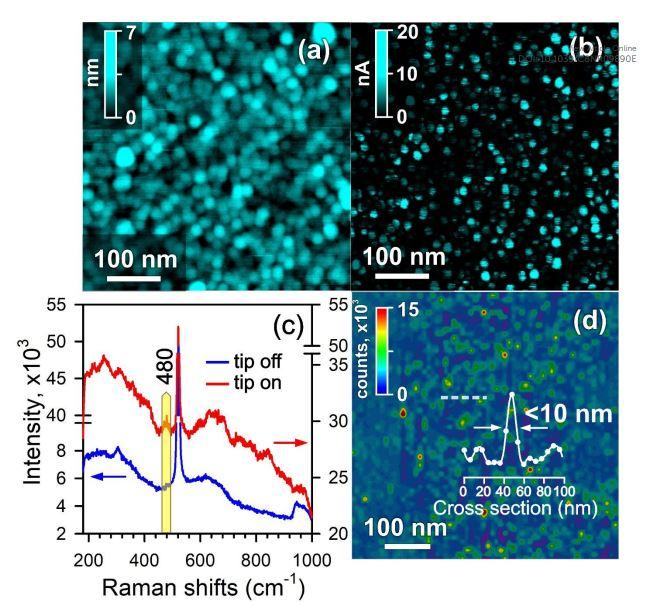New way of optical visualization of nano objects proposed

Figure 1. (a) AFM topography and (b) dc electrical current map of the 50 nm thick TiON film. (c) Far-field (tip off) and near-field (tip on) Raman spectra, and (d) TERS mapping at 480 cm-1 of the same film. Credit: Kazan Federal University
High-resolution optical microscopy methods promise breakthroughs in materials science, biology, and medicine. Today, their possibilities basically reach those of scanning electron microscopy.
Sergey Kharintsev, Head of Nano-Optics Laboratory (Kazan Federal University), comments, “The main advantage of optical microscopy is that it provides nondestructive chemical analysis of single molecules exposed to continuous-wave low-powered laser light.
Unlike scanning electron microscopy, this allows one to perform 3D visualization and spectral analysis of intrinsic structure of nano objects, and also get insights into processes in living cells.”
According to Professor Kharintsev, fluorescence microscopy has become the most popular method for biology and medicine lately. Its main drawback is the need for fluorescent labels that must be photostable and non-toxic. Furthermore, there are factors of labor-intensive sample preparation and fluorophore prices.
The paper posits that one of the solutions for ultrahigh resolution microscopy is a superlens, first proposed by John Pendry (Imperial College London, UK) in 2000. The lens looks like a sandwich with a metallic film placed between two dielectric layers.
Superresolution is achieved due to the optical near-field enhancement through surface plasmon resonances. Lately, a breakthrough initiative in practical implementation of such superlens has been put forth by Vladimir Shalaev (Purdue University, USA), who suggested using a nano-composite metal-dielectric film. This permits the superlens to be operated at a tunable single frequency.
“We propose to use a nano-structured metal-dielectric film that exhibits a double epsilon-near-zero behavior near the percolation threshold,” continues Sergey Kharintsev. “The material in question is titanium oxynitride, a compound first synthesized by Andrei Mihai's group at Imperial College London.
Such a superlens provides ultrahigh spatial resolution due to stimulated Raman scattering. Consequently, we have succeeded to achieve a spatial resolution of 8 nm and 80 nm in the near-field and far-field, respectively. Importantly, obtained optical images are formed with a standard objective only, not using optical nano-antennas, designed laser beams, or fluorescent labels.”
###
The research has been supported by the Russian Science Foundation. The project's title is “Synthesis and research of ultra-thin magnetic heterostructures with potential spintronic and optronic applications”; Professor Lenar Tagirov (Institute of Physics, Kazan Federal University) is at the helm. Sergey Kharintsev's PhD student Anton Kharitonov has prepared his PhD thesis based on the results.
Media Contact
All latest news from the category: Physics and Astronomy
This area deals with the fundamental laws and building blocks of nature and how they interact, the properties and the behavior of matter, and research into space and time and their structures.
innovations-report provides in-depth reports and articles on subjects such as astrophysics, laser technologies, nuclear, quantum, particle and solid-state physics, nanotechnologies, planetary research and findings (Mars, Venus) and developments related to the Hubble Telescope.
Newest articles

Superradiant atoms could push the boundaries of how precisely time can be measured
Superradiant atoms can help us measure time more precisely than ever. In a new study, researchers from the University of Copenhagen present a new method for measuring the time interval,…

Ion thermoelectric conversion devices for near room temperature
The electrode sheet of the thermoelectric device consists of ionic hydrogel, which is sandwiched between the electrodes to form, and the Prussian blue on the electrode undergoes a redox reaction…

Zap Energy achieves 37-million-degree temperatures in a compact device
New publication reports record electron temperatures for a small-scale, sheared-flow-stabilized Z-pinch fusion device. In the nine decades since humans first produced fusion reactions, only a few fusion technologies have demonstrated…





















